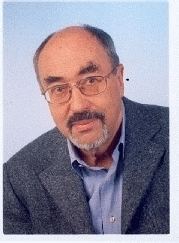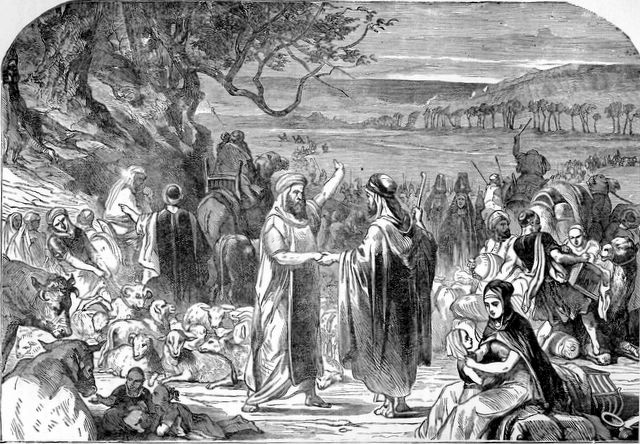So Abram went, as the Eternal had spoken unto him; and Lot went with him… And Abram took Sarai his wife, and Lot his brother’s son… (Genesis 12:4-5)
And Abram went up out of Egypt, he, and his wife, and all that he had, and Lot with him, into the South. (Genesis 13:1)
And Lot also, who went with Abram, had flocks, and herds, and tents. And the land was not able to bear them, that they might dwell together; for their substance was great, so that they could not dwell together. And there was a strife between the herdmen of Abram’s cattle and the herdmen of Lot’s cattle. And the Canaanite and the Perizzite dwelt then in the land. And Abram said unto Lot: ‘Let there be no strife, I pray thee, between me and thee, and between my herdmen and thy herdmen; for we are brethren. Is not the whole land before thee? separate thyself, I pray thee, from me; if thou wilt take the left hand, then I will go to the right; or if thou take the right hand, then I will go to the left.’… So Lot chose him all the plain of the Jordan; and Lot journeyed east; and they separated themselves the one from the other. Abram dwelt in the land of Canaan, and Lot dwelt in the cities of the Plain, and moved his tent as far as Sodom. (Genesis 13:5-11)
The Torah begins the ancestral story of the nation of Israel with the journeys of our forefather Abraham and his nephew Lot. They both grow rich, and strife breaks out between the herdsmen of Abraham and the herdsmen of Lot. When riches grow, so do family feuds. It appears on the surface that there is nothing unusual about this narrative. However, it may be a metaphor for an obscure but essential concept in quantum physics—decoherence.
Essentially, quantum decoherence is the loss of quantum coherence. According to the particle-wave duality introduced by Louis de Broglie, all objects (photons, electrons, and all subatomic particles) have waves (now called “de Broglie waves”) associated with them.[1] Therefore, all quantum-mechanical objects possess wavelike characteristics, such as frequency,[2] wavelength,[3] and phase.[4] In classical physics, coherence describes the statistical similarity of a field at two points in space or time. The coherence of the two waves expresses how well they are correlated. For two perfectly correlated waves, their phase difference will stay the same. This property allows two waves, when combined, to constructively or destructively interfere with each other, producing an interference pattern. The light produced by a tungsten lightbulb lacks coherence, because each point on the filament produces waves or light independently, and waves have no fixed phase relationship. On the other hand, laser light usually produces a light beam with a high degree of coherence. Holography requires perfectly coherent light, which is why lasers are used to produce holograms.

Decoherence was introduced by the German physicist H. Dieter Zeh (1932–2018) in 1970. Decoherence can be viewed as the loss of information into the environment (similar to the information loss due to heat dissipation into the environment).[5] If a quantum system is perfectly isolated, it will maintain coherence indefinitely; that is, the system will continue to exhibit definite phase relation between different states. However, it is impossible to investigate or manipulate a perfectly isolated system. If it is not entirely isolated, such as during a measurement, coherence is shared with the environment and will be lost with time—a process called quantum decoherence.
Quantum entanglement strongly correlates with coherence, and quantum disentanglement strongly correlates with decoherence.
In theoretical physics, the collection of all properties of a system is called a state. This concept plays a key role in quantum mechanics, since each system has a state (traditionally denoted by the Greek letter psi, Ψ[6]). Suppose our state is a sum of two other states, Ψ1 and Ψ2.[7] If we were to decompose our original state Ψ into the sum of its constituent parts (Ψ = Ψ1 + Ψ2) and then recombine those parts, our intuition tells us that we should get the original state Ψ. But this is not what happens. Each state Ψ1 and Ψ2 interacts with the environment, simultaneously affecting the environment and being affected itself. This is an irreversible process.
But what does this all have to do with Abraham and his nephew Lot? The first verse of this Torah portion states:
Now the Eternal said unto Abram: “Get thee out of thy country, and from thy kindred, and from thy father’s house, unto the land that I will show thee.” (Genesis 12:1)
In Kabbalah and Chasidut, this verse is interpreted mystically as the commandment to Abraham (at the time called Abram or, in Hebrew, Avram) to leave his lofty place in the world of Atzilut and descend into this world. As Rabbi Schneur Zalman of Liadi, the Alter Rebbe, writes in Likkutei Torah, the name of Avram can be broken down as Av-ram. Av (which in Hebrew means “father”) alludes to the level of chokhmah (wisdom), whereas Av-ram stands for “hidden intellect”—the highest level of chokhmah. From this exalted level, Avram is commanded to travel to the “land”—which, in Kabbalah, signifies the sefirah of Malchut—the lowest of the sefirot.
In another place,[8] the Alter Rebbe states that while in Atzilut, Abram includes Lot—they are one unit. Their familial relationship is an allegory for quantum entanglement. If they were quantum-mechanical objects, they would be described by the combined state ψ. Indeed, on this level, Abram and Lot are entangled. That is why Lot follows Abram when they leave their home in Horan, and he continues to follow Abram from the land of Egypt. However, Abram’s descent from his spiritual heights into this world was necessary for him to spread the idea of monotheism among the people of his generation. To accomplish this task, Abram had to enter a hostile environment to proselytize monotheism. This dissipation of information necessarily leads to decoherence, as Abram remains the righteous man he always was, whereas Lot gets out of sync with Abram and loses his moral compass, as evident from his settling in Sodom—the capital of immorality.
It is this moral “decoherence” that leads to ultimate disentanglement between Abraham (still called Abram at that time) and Lot, who separate and go their own ways, in different directions.
Or, to look at this from another point of view, in the world of Atzilut Abraham and Lot were in one coherent state Ψ. Once they descended into this material world, they separated into two separate states, Ψ1 and Ψ2. Their interactions with their environment both affected it and affected them, a mutual interaction that, as mentioned above, is an irreversible process. The sum of ψ1 and ψ2 is no longer the original state ψ—in other words, Abraham and Lot decohered. This decoherence manifested itself in their feud and separation.
Thus, this seemingly simple story of a family feud can serve as a vivid metaphor for quantum decoherence.
———————-
Footnotes:
[1] In a famous double-slit experiment, electrons can behave like waves painting light and dark stripes on the second screen—an interference pattern characteristic of waves interfering with each other—where bright bands result from constructive interference and dark bands result from to destructive interference. This ability to interfere is related to coherence.
[2] ν = E / h, where ν is the frequency of the wave, E is the energy of the object (e.g., electron), and h is the Planck constant.
[3] λ = h / p, where λ is the wavelength, p is the momentum, and h is the Planck constant.
[4] The phase of a wave is an angle representing the number of periods spanned by time.
[5] The loss of the information into the environment and the resulting decoherence presents significant technical difficulty for quantum computing, which requires maintaining coherence to carry on quantum computations.
[6] In bra ket notation used in quantum mechanics, the state is written as |ψ〉.
[7] More precisely, this state should be written in bra-ket notations as (|ψ1〉 + |ψ2〉)/√2.
[8] Torah Ohr, Lech Lecha, Maamar Hinei Avrom.
